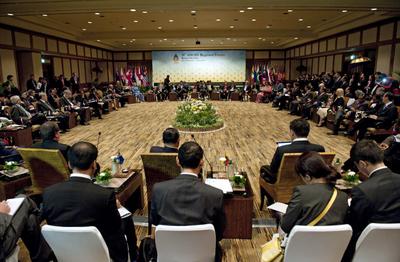After nine years such an agreement may not seem a big deal, but it is a step in the right direction and will hopefully serve to reduce current tensions.
While ASEAN Secretary-General Surin Pitsuwan was effusive about the breakthrough, the Philippines was rather skeptical about what the guidelines could achieve when one of the parties, China, seemed to claim almost all of the Sea. But ASEAN’s view is that the guidelines are an initial step that must be followed up by more specific measures. And the diplomats will, no doubt, have their work cut out for them to reach a better understanding between the disputants for more effective implementation of the DoC.
As expected, US Secretary of State Hillary Clinton’s efforts played an important role. By reiterating US interests in the South China Sea, and calling on the claimants to back their claims with legal evidence (in this case ensuring conformity with the United Nations Convention of the Law of the Sea or UNCLOS), Clinton effectively established the US as a de facto party in the facilitation of a peaceful settlement of the disputes. Her remarks did not elicit the kind of anger that Chinese Foreign Minister Yang Jiechi reacted with (to similar statements from Clinton) at last year’s ARF meeting in Hanoi. This is despite Yang’s reported recent comments that Washington should not interfere, and indicative that China was not surprised by Clinton’s remarks.
Clinton’s stance helped reinforce the point, which needs to be constantly repeated: ASEAN as a whole as well as other states have significant interests in the Sea and in how the disputes are resolved — despite, in a narrow sense, the South China Sea disputes being between China and four ASEAN states. These other states include the US and maritime and trading nations like Japan, South Korea, Australia, New Zealand and India.
The stakes are especially high for Washington given its security treaty with one of the claimants, the Philippines, which could potentially draw the US into an undesirable conflict. By spelling out Washington’s position clearly and forthrightly, Clinton’s hope is to provide a stabilising influence. The firm and clear stance the US has taken is a necessary condition for any peaceful resolution of the disputes in accordance with international law. Further, Washington’s position assists the traditional ASEAN preference for an inclusive approach in dealing with problems, and helps prevent ASEAN from being isolated in its dealing with China.
But, ultimately, what the international community and ASEAN countries want is continuation of the high seas status to much of the South China Sea — guaranteeing freedom of navigation under international law, not by licence of any state claiming ownership. Given this, Foreign Minister Yang’s assurances that freedom of navigation through the Sea is guaranteed mean little if China’s position is one that stakes ownership to much of the waters, something the yet-to-be-clarified nine-segment line seems to suggest. This is why implementation of the DoC remains a far cry from progress towards ending the territorial disputes themselves. And this remains a matter which cannot be resolved without some shift in the policies of China itself.
Daljit Singh is Senior Research Fellow at the Institute of Southeast Asian Studies, Singapore.

